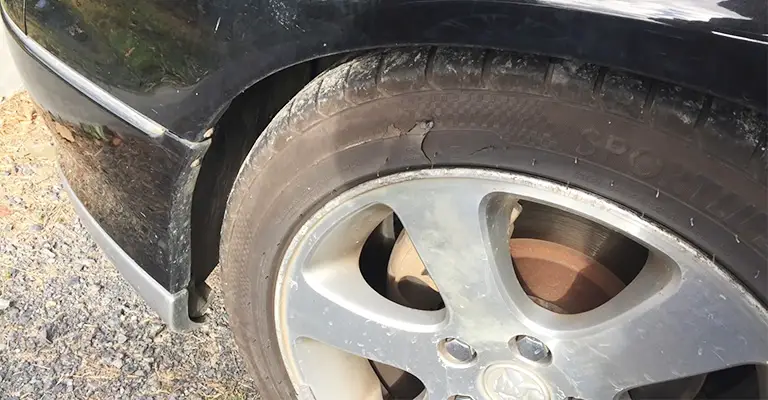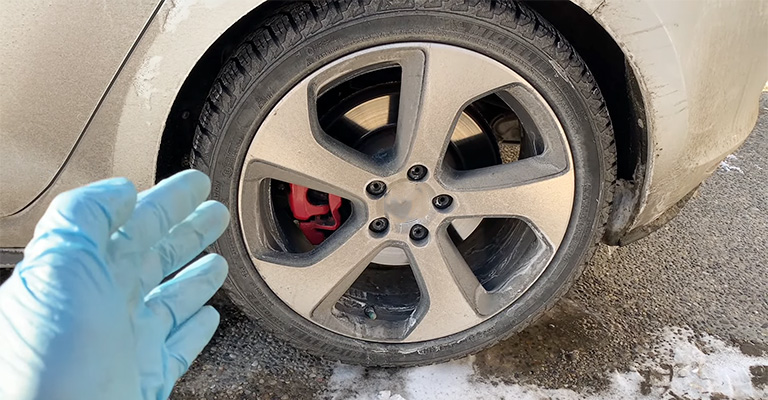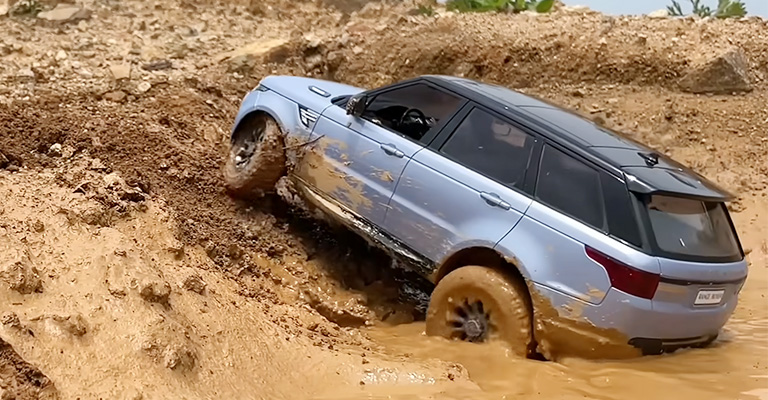Even though modern tires are thicker than before, they aren’t immune from all damages. And tire sidewalls are a bit more vulnerable to puncture. City drivers often witness a small chunk of tire sidewall missing.
Sidewall damages happen when the tread blocks break. This occurs due to both rush driving habits and environmental effects. Whatever the reason, if the missing part causes air leaks, you need to repair the tire immediately. Driving with a defective sidewall may blow out sooner or later.
There are temporary and permanent fixing methods to recover your tires from this risk. I’m gonna share how you can do it yourself within 1 hour and save 50 bucks worth of repair costs.

Causes of Tire Sidewall Damages
Reasons you end up with tire sidewall damage can vary depending on some factors. Mostly, it happens due to rough driving. Another notable culprit is the environment. Let’s check out the causes in the common scenarios.
Environmental Factors Cause Sidewall Damages the Most
As tires are always exposed, they often get contact with external elements such as temperature, debris or roadside sharp materials, etc. These cause sidewall damages in the following ways.
Temperature Fluctuations

Both excessive and low temperatures are bad for your car tires. Excessive sun exposure dries out the rubber of the tire. And the sidewall’s moisture goes away, making them fragile.
On the contrary, a drop in temperature also affects the tires. They lose an average of 1 PSI air/per month if the temperature drops 10°F, influencing the under-inflation rate.
Roadside Sharp Objects
Offroad and highways are full of unexpected sharp objects, including nails, broken glasses, etc. Contact with them may not initially result in a punctured tire but pricks or cuts the rubber.
After a while, these create cracks that make the tire brittle. It’s another common reason tires’ sidewalls get missing all of a sudden.
Rough Driving Habit Causes Sidewall Damages Too!

No offense, but I should admit. Whether intentional or not, sometimes, it’s you who causes such kind of damage to the tire. Three of the most common driving practices I’ve seen causing sidewall cracks are:
Under Inflation
Some drivers are prone to aggressive driving habits. Because of this practice, car tires often result in under-inflation, which eventually causes sidewall damages (sometimes sidewall blowouts.)
Most city car tires feature 30 to 35 PSI (pressure standard) air. Due to inflation, your tires lose an average of 2 PSI/month. When the inflation rate meets 25%, your car tire sidewall will blow out.
Offroad Driving

City cars don’t always feature tires that can handle unpaved roads’ torture. Driving on those bumpy terrain harms your tires’ longevity. If you frequently drive on such roads, the sidewalls will get cracks.
Harsh Turning
It’s needless to mention how badly it impacts your tires when you take sharp turns during driving. Because of the action, the tires scrape against the curb. As a result, the side part of your tires started to tear gradually.
Should You Drive with a Sidewall Missing or Damaged Tire?
Before discussing whether you should drive with sidewall-damaged tires or not, first, let’s go through the experience.
When this issue occurs, your ride becomes overwhelming and bumpy. The stored air amount decreases significantly in no time. Therefore, you would feel uncomfortable controlling the wheels. Being stuck in such a situation will immediately turn your ride to hell.
If considering the safety measures, I won’t advise you to drive with a missing chunk of sidewalls. Because –
- Missing chunks of the sidewall reduce tire traction that it used to have.
- Rims will get stronger interaction with the road, eventually causing abrasion.
- It’ll cause under-inflation to your tires, resulting in a tire blowout soon.
- If the wearing becomes larger, only repair won’t work. You’ll have to replace the existing tire permanently.
How to Fix Tire Sidewall Damages?
There are 2 types of fixing methods you can follow to recover a damaged sidewall tire. The first one gives you an emergency escape so you can continue driving with the broken tires for a few days. And the second method allows you to use it for months. I’m gonna go through each of them in this section.
Method 1: Fixing Sidewall Chunk Missing with Plugs
Using a tire plug kit is a temporary trick to repair sidewall holes. These are also known as sticky tire strips. However, it’s super easy. So, even you can do this without any professional help.
Requirements:
- Tire Plug Kit
- Rubber Cement or Tire Glue (if it doesn’t come with your plug kit)
- Flat Screwdrivers
- Knife
Step 1: Cut Plug According to the Hole
To get started with the process, first, measure the size of the missing sidewall part. If the diameter is small (⅛-inch), cut a single strip into two and use one.
For ¼-inch, you’ll need one plug. You can use multiple plugs (according to the hole diameter) if the hole’s size is bigger than usual.
“If the hole diameter is more than 2-inch, you’ll need 10-12 pieces of plug or strips. It’s because bigger holes stretch the rubber.”
Step 2: Inserting Sticky Plug into the Hole
Let’s go ahead and remove all the air out of the tire. To do so, remove the tire’s valve stem using a flat screwdriver.
Then apply some tire glue or rubber cement on and around the hole. Next, neatly and carefully push the plug into the hole via the screwdriver. You can add more glue if required after pushing the plug inside the hole.
“The sticky plug seals up the hole, and actual glue helps it keep it in place.”
Step 3: Creating a Mushroom Effect
Yes, this is what happens inside when you pull out the plug bit with pliers. It helps you seal the hole a lot better.
Let the glue sit for at least 30 minutes (the time may vary depending on the type of plug you’re using) before starting to air it up.
Step 4: Inspect and Cut
Finally, when the glue is dry enough, air the tires up. Make sure to check the seal if there’s any leak carefully.
The best way to do it is to apply some water to the sealed area. If there’s still any leakage, the water will start bubbling.
Cut the extra plug out of the hole with a blade or knife.
Method 2: Permanent Repair for Sidewall Damage
I’m assuming you’ve applied the above method initially. After a few days (sometimes months), you’ll need to get a better repair. So, find a break, follow the steps below to fix the missing sidewall permanently, and turn the tires like new.
Requirements:
- Right Angle Die Grinder
- Curved Needle
- Rubber Weld (PR100 or PR40)
- Nylon Thread
- Old Car Tire
- Carbon choke cleaner (optional)
- Knife
If you don’t want to follow “Step 3” given below, buy a tire patch kit.
Step 1: Remove Glue Plugs (skip this if you don’t have them)
Remove all sticky strips if you’ve added them earlier. Simply pull them out with a plier.
Step 2: Clean and Degrease Hole Area
Now, let’s prepare the wound for treatment. Wipe it off with a cloth. Having existing grease will cause problems in the further steps. So, apply some carb truck cleaner to degrease the hole area.
Use a die grinder to sand the area around the hole. It’ll make the surroundings flat, so it becomes easier to patch it up later.
Step 3: Make a Tire Patch
Time to utilize your spare junky old car tire in the garage. You just need a chuck out of the sidewall. With this, you can create a natural patch for the hole.
Measure the hole area and slice a piece from the old tire accordingly. Use your knife to sand off the little ridges of the cut piece.
“If the hole size is 1-inch, the patch should be at least 2-inch × 1.5-inch dimension.”
Step 4: Stitch the Sidewall Hole (Only required for holes size bigger than 1-inch)
For a long-lasting repair, you’ll need to seal the hole with threads. Use the upholstery needle and nylon threads for the purpose. There is no rule of thumb for this. Just make a couple of tight stitches.
Step 5: Apply Rubber Weld
Rubber welds work like magic in this case. They are basically Superglue for rubbers. If you use PR100, you’ll get a thicker gluey result than PR40. Now, rebond the tear of the sidewall by adding some weld there.
Step 6: Add the Patch
If you’re using a DIY tire patch, make the front leading edges with the help of your grinder. It’s better to make them tapered. You can do the tapering with a razor blade as well.
Then apply enough PR100 on one side of the patch, which you’ll attach pointing to the hole. Keep it for a day to completely dry.
“Make sure you’re not leaving any dry areas. Otherwise, you’ll witness air leakage afterward.”
Frequently Asked Questions
Can I drive with a chunk out of my tire?
You can drive with a chunk out of your tire if it’s less than 1 inch and not deepen much towards the tube. Anything bigger than that requires immediate repair if you don’t want to witness a sudden tire blowout.
Is a chunk out of the tire sidewall MOT?
Yes, if a chunk goes out of the tire sidewall, it could fail and eventually MOT.
Can you fix a small hole in the sidewall of a tire?
You can fix a small hole in the sidewall of a tire either with a plug or patch kit. Using plugs is more like a temporary solution. For a long-lasting fix, go for patching. Check out both above.
Why do my tires have chunks missing?
Your tire’s missing a chunk because the tread blocks have been cracked. The reason can be either your rush driving or external element contact.
Conclusion
Once missing a small chunk of tire sidewall missing might’ve worried you. But it won’t anymore because now you know how to fix it following temporary and permanent methods. It’s always wise to treat the issue earlier, even though the crack is smaller. Otherwise, you may end up with flat tires.
Leave a Reply